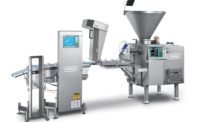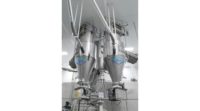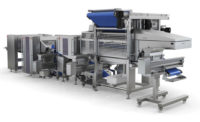Companies seek automation, efficiency, labor savings from dough handling equipment
Depositors are being updated with more servo-based offerings.

courtesy of Handtmann
Snack food and wholesale bakery companies in the market for dough-handling equipment such as dividers, depositors, and rounders have been increasingly focused on machines that provide greater automation, along with the corollary efficiency and labor savings.
“We’re trying to take some of the variables out of the operator’s hands,” says Bruce Campbell, vice president, dough processing technologies at AMF Bakery Systems, Richmond, VA. Those include recipe formulas, scaling, and pan guides for its dividers, he says. “Everything self-adjusts.”
Shaffer, Urbana, OH, has automated its divider-hoppers in such a way as to alert the mixer that it’s time to start the next batch, says Andrew McGhie, director of sales. “In 70% to 80% of bakeries, that’s still something the operator has to activate,” he says. “The only time the operator actually gets involved is when it’s time to add minor ingredients. … With the pandemic, it’s of more interest to the customers to push the envelope on automation.”
Unifiller Systems, Delta, British Columbia, has updated its depositors with more servo-based offerings that eliminate human effort while boosting control, says Sonia Bal, director of global marketing. “Servo technology allows for quick spreading, due to constant speed regardless of pressure,” she says. “Customers can build and recall recipes, up to 100 stored recipe configurations, while the system also conducts performance monitoring, collecting useful data on production rates, cycles, and deposits.”
Handtmann, Lake Forest, IL, also has moved in the servo-driven direction with its depositors, achieving labor savings because fewer people are now required to handle changeovers, says Ken Hagedorn, vice president of bakery sector. “Probably in a matter of five or 10 minutes, you can switch from a ham-and-cheese filling to apple filling,” he says. “It’s made for a quick changeover."
Handtmann
DS552
Handtmann has upgraded its basic divider to a servo-driven machine with as many as 24 rows across, Hagedorn says. “The single machine does its job great,” he says. “But the issue is, what do people do when they want to run multi-rows? You can only have one head coming out of there. The issue is, how do you get multi-rows out of single heads? … If we divide it into four rows, there’s no guarantee that every one of those rows is going to be even and accurate.”
The upgraded DS552 is heavy-duty, all-stainless steel and USDA-grade washdown, with attachments easy to slide off for changeover and cleaning purposes, Hagedorn says. “You don’t need to be Arnold Schwarzenegger” to remove parts, he says. “All these things are made to be washdown. Cleanability is real important. You can take it to a washroom, hose it down and put another component in there.”
The forming tools for the machine are all made to be disassembled, Hagedorn says. “You can put another attachment on, if you’re changing sizes, or doing something different with cutting or co-extruding, it’s easier to change the makeup tools for the final product,” he says.
AMF Bakery Systems
ADD-S
AMF Bakery Systems recently completed an extensive redesign of its Advanced Dough Dividers, now dubbed the Advanced Dough Dividers-Sanitary, or ADD-S, Campbell says. The 30-year-old line has been upgraded so that it’s “very, very clean; very, very sanitary,” with stainless steel construction and “no penetrations in the frames where things can harbor,” he says.
“It has an open design, so there’s no belts or chains to worry about having to guard,” he adds. “We also changed some of the inner workings of the machine so that it handles more of these stiffer products we have these days, like organic and heavily seeded doughs. It also has improved pre-scaling accuracy, higher levels of controls and automation setup, interfacing with the plant production systems for visibility into how the machine is operating.”
On the buns side, AMF has upgraded its AccuPan system to provide features that remove some operator duties, including automated belt tracking and automated temperature controls, Campbell says. Next will be an automated, streamlined weighing system that will provide information to the divider to make individual lane adjustments to maintain scaling, he says.
Shaffer
Automated traversing chunker
Shaffer manufactures dough pumps, chunkers, and conveyors that take the dough from a horizontal mixer to the divider or former, McGhie says. “The traversing chunker can move between the two mixers, receiving the dough from each mixer, portioning it into dough chunks and transporting the dough chunks using vertical and horizontal conveyors to the divider- or former-hopper,” he says. “This can be highly automated, with the chunker automatically traversing between hoppers.”
The upgrade to automated traversing chunkers helps from a safety point of view because a staffer previously would have needed to be stationed between the two mixers to make sure no one got run over, McGhie says. “Safety and scanning technology has gotten a lot better in the last five years,” he says. “Now, just mounting scanners on the traversing dough chunkers, so basically they can operate automatically. If it sees a person, it will stop. And then you can hit ‘reset’ and it keeps going. You don’t need to have the whole area enclosed” for safety purposes.
The automation extends to signals from the divider-hopper that tells the chunker it’s time to chunk more dough because the divider-hopper is running out. “I’m nearly out of dough here; I’m going to be out of dough in 10 to 15 minutes,” McGhie explains. “It sends a signal to the mixer to start the next batch.”
Unifiller
New GF depositors
Unifiller has tested and rolled out a line of gluten-free dough depositors that use existing technology but with functional upgrades to handle various kinds of gluten-free batters, Bal says. “Specifically, we’ve been very successful in portioning and depositing thin pizza crust disks with automation, which is unique to Unifiller,” she says.
Other features that Unifiller has brought forth include a servo-controlled turntable station for the dough disk deposit, and a mode for adding a ring to the crust, Bal says. “The system can be used standalone for single portions over or a line,” she says. The system “offers versatility to be used for other application with four depositing modes: depositing, spreading, multi-row, and continuous.”
The system also offers a height-adjustable frame, and a PLC control system with touch-screen interface and 100-recipe storage, Bal says. “The GFP Station repeatedly and consistently deposits gluten-free dough batters, regardless of batch or deposit speed,” she says.
Looking for a reprint of this article?
From high-res PDFs to custom plaques, order your copy today!







